16.11.2005
S.KLIMOV. PORTRAIT OF A CHESSPLAYER - EMIL SUTOVSKY
Though such a selection criterion is beyond any doubt – as the strongest chessplayers of the world deserve to have their portraits painted more than others – it overlooks some outstanding and sometimes even more interesting in creative respect players, who have not approached the throne closely. And, very likely that in the aggregate of rating and "brilliance" of style, Israeli grandmaster Emil Sutovsky can be considered the leader among such creative chessplayers nowadays. Usually one has to select the most notable examples of a player's games – brilliant intuitive sacrifices, unusual attack, and wins over the leading grandmasters. However, I'm afraid that in this case this path is not suitable. The amount of examples of brilliant games so much exceeds all reasonable limits, and these examples are so well known – they were published with annotations in the Informator, databases, magazines, on chess websites (Sutovsky, for example, has been a laureate of "Game of the Week") – that it's impossible to run through all of them in one article, as in this case the article itself will turn into a compilation of Sutovsky's and his opponents' annotations. Besides, a clumsy portrait painted in bright colours only, will hardly reflect a chess individuality of the article hero. Trying to describe chess individuality of Sutovsky in one word, I would call him an easily-carried-away player. Let's take a sporting situation that is standard for chess. Chessplayer X, who has White, runs across a novelty in the opening and in a few moves appears in a position, in which he understands that in case he plays a few more moves normally and calmly, Black will carry out a desirable maneuver, seize the initiative and stand perfectly. The course of events can be turned only by an extremely unclear sacrifice. Numerous possible responses to the sacrifice are dancing before the eyes, it is impossible for a human being to calculate all possibilities of the opponent; intuition emphatically repeats "it will hardly work!", though the idea is certainly beautiful. A "practical man" will look at the things (by "things" I mean board with pieces, clock and partly... the opponent's rating), and in fifteen minutes of thinking will reach a clear decision – not to give anything, abide an unpleasant position and carefully play for a draw. A "romantic" will give away material, and afterwards everything will depend on his calculation skills and objective assessment of a position. No matter how strong the former may be, if the objective refutation exists, only a miracle can hamper a strong opponent to find it. And miracles do not occur always. Sutovsky – Ivanchuk The eighth round of the "Aeroflot". It is still unclear what exactly is at stake in this game, but it is clear that quite a lot in money terms. 1.e4 c5 2.¤f3 e6 3.d4 cxd4 4.¤xd4 a6 5.¤c3 Јc7 6.Ґd3 ¤f6 7.Јe2 Ґd6. This is a variation in which Sutovsky beautifully defeated Kunte in Puna last year: 7...b5 8.e5 b4 9.¤cb5 axb5 10.¤xb5 Јb7 11.exf6 gxf6 12.Ґf4 ¦a5 13.Ґc4 ¤c6 14.0–0–0 b3 15.cxb3 ¦xa2 16.ўb1 ¦a5 17.¦d5! 17...Ґe7 18.¦hd1 ¦g8 19.¤c7+ (19.g3!?) 19...ўd8 20.¦xd7+ Ґxd7 21.¦xd7+ ўc8 22.Ґxe6 ¤e5 (22...¦e5!) 23.¤b5! Јxb5 24.¦d5+ fxe6 25.¦xb5 ¦xb5 26.Јxb5 ¦g6 27.Јe8+, Black resigned 8.¤f3. Original attempt of improving White's play, implemented by Volokitin against Svidler in Bundesliga 2005: 8.g4 (ignoring the weakness on f4) 8...h6 9.Ґd2 ¤c6 10.¤xc6 dxc6 11.0–0–0 b5 12.h4 g6 13.ўb1 e5 14.g5 ¤h5 15.gxh6 Ґf8 16.Ґg5 Ґxh6 17.Јe3 Ґxg5 18.hxg5 Јa7 19.Јd2 Ґd7 20.f4 exf4 21.Ґe2 0–0–0 22.Ґxh5 ¦xh5 23.¦xh5 gxh5 24.Јxf4 Ґe6„. 11...exd5. The one who sacrifices has to shovel more variations than the one who accepts a sacrifice. For example, in this case the knight could be ignored and one could play 11...Јb8 12.h3 ¤ge5. 15...0–0 (certainly, castling is very significant psychologically) 16.h3 ¤g6! (16...Ґxf4? 17.hxg4 Ґd6 18.¦xe7 Ґxe7 19.Јf5!!ќ) 17.Ґxg6 (17.Ґxd6 Јxd6 18.hxg4 ¤xh4 19.Јh3 ¤g6 20.gxh5 ¤f4°) 17...Ґxf4 (17...fxg6 18.¤xg6 Ґxf4 19.¤xf8 ¤xf2! 20.¤g6!! ¤e4+ 21.ўh1 ¤g3+=) 18.Ґxh5 ¤f6 19.¤f5 (19.Јxf4 ¤xh5 20.Јg5 g6 21.¤f5 (21.¤xg6 fxg6 22.Јxg6+ ¤g7°) 21...d6µ) 19...Ґd2 20.¦e2 Јxc2 21.Ґg4 (21.¤d4 Јh7) 21...d6 22.¤d4 Јxb2 23.¤b3 Ґxg4 24.hxg4 ¦ac8 25.¦xd2 Јe5µ – White is worse but the material is equal. 15...Ґxf4 16.Јxf4 g5! Vasily Ivanchuk in his annotations recommends positional (!) 15.Ґxd6 Јxd6 16.g3 ўd8 17.b3 (… c4) (17.Јf3 ¤e5 18.Јf4 f6 19.¦ad1 Ґb7µ) 17...b4 (17...Ґb7 18.c4 ¦c8 19.¦ac1›; 17...¤xd5 18.¤f5 Јf6 19.Ґe4 ¤c3) 18.a3 bxa3 19.c4 Ґb7 20.b4і – Ivanchuk. It is not the most standard "і", is it? 18...Ґg3 (18...g6 19.¦ab1!) 19.¤f5 (19.Јxe7+ Јxe7 20.¦xe7+ ўxe7 21.¤f5+ ўe8 22.¤xg3 ¤f2+ 23.ўh2 ¤xd3 24.cxd3°) 19...¤f2+! After this check it becomes clear that Black's win is a question of technique. 26.Ґxf4+ ўf8 27.Јa3+ d6 28.¦ad1 Јc6° 29.¦e2 (29.Ґxd6+ ўg8°) 29...Ґe6 30.Ґxd6+ ўg8 31.Ґe5 ¦h6 32.¦ed2 ¦g6 33.g3 ўh7 34.¦d8 Јb6+. White resigned, but as a reward for the sacrifice Emil won the tournament having lost in the penultimate round – an extremely rare case! Sutovsky – van Wely 1.e4 c5 2.¤f3 d6 3.d4 cxd4 4.¤xd4 ¤f6 5.¤c3 a6 6.Ґe2 e5 7.¤b3 Ґe7 8.0–0 0–0 9.ўh1 Јc7. It's rarely played now, as main disputes concentrate on 9...¤c6 10.f3 Ґe6 11.¤d5 a5. 10.g4 Ґe6 11.g5 ¤fd7 15.Ґe3 Јc7 16.a3. Allows White undertake b4 quickly and avoid the blockade of the queenside. 16...¤d7 (16...a5 17.Ґb5! … c4, b4±) 17.c4 a5 18.b4±. From the very beginning Black turned out to be locked up at the back ranks – he does not have a usual e5 for a knight; the kingside play with f7-f5 after the capture en passant will only provide white light-squared bishop with a diagonal, creating anything on the a-file is also unrealistic. 18...¦fc8. Since Black cannot exert a pressure on the c4-pawn anyway, this provocation of moving the bishop on g4 is hardly successful. 19.Ґg4 ¦d8 20.Јb3 ¦a6 (20...¤b6!?) 21.¦fc1 axb4 (21...¦da8 fails to 22.b5 a4 23.Јb4 ¦a5 24.Ґxd7 Јxd7 25.Ґb6ќ) 22.axb4 ¦da8 23.¦xa6 ¦xa6. 24.c5! ¦a8 (24...dxc5 25.bxc5 ¦a5 (25...¤xc5? 26.Ґxc5 Ґxc5 27.Јb5ќ) 26.c6 (26.Ґxd7 Јxd7 27.c6 bxc6 28.dxc6 Јc7 (28...Јd8 29.Јb7 Јd5+ 30.ўg1 Ґf8 31.Јc8ќ) 29.Јb7 Ґd8 30.¦d1ќ) 26...bxc6 27.¦xc6 Јd8 28.d6 Ґf8 (28...Ґxg5 29.Ґxg5 Јxg5 30.¦c8+ ¤f8 31.¦xf8+) 29.Јb7ќ. 25.Јc4 ¤f8 26.Јb5! A master maneuver. On c5-c6 Black needs to block the flank by b7-b6 somehow. Now, in order to have an opportunity of b6, he has to play 26...Ґd8, and then 27.Јe8 (threat of cxd6 and Ґc5) 27...¦b8 28.Јa4! White took the a-file away from the opponent and Black is in comatose state. 33.Ґf5. Another adroit move. 33...g6? Deprives Black of the last counterplay opportunity. Given by Sutovsky 33...¤g6! 34.Ґxg6 (otherwise ¤f4) 34...fxg6 35.ўg1 Јf7 36.ўf1 is correct - White has an advantage, but it's still unclear how to break through. A magnificent rich play with domination all over the board. Mikhail Moiseevich would have given an exclamation mark to the move a2-a3, having explaind the essence of the move. Garry Kimovich in the time of his multivolume work would perhaps have undertaken the in-depth computer analysis of the game, and pointed that Black's move 9 had been inaccurate; in the following play he would have found about five inaccuracies of each player and would have found ways of making a draw for Black. Finally, Vladimir Kramnik would have explained us finesses of White's positional concept and would have indicated how and where Black could have prolonged the resistance. Emil Sutovsky just put exclamation marks to the moves 16, 24, 26, 27, 28, 35, 37, and 40 of White. Another interesting style peculiarity of our hero is that he is fond of making "troublesome" moves. It reminds of pressing in football, when the opposite side has a ball and is able to keep it and pass it where he needs (in our case he has solid and well-defended position), but anyway troubling him is useful, as he might become nervous and give the ball away. There is an underside of it – one can go too far, make a move that does not meet the position's demands and be punished. Grischuk – Sutovsky Sutovsky undertakes a kind of queen dancing instead of solid development 12...Јc6?! (12...¤bd7 13.¤bd2 h6 14.¦fe1 e5›) 13.¤bd2 (13.e5 ¤d5 14.Ґg5 h6 15.Ґh4 Јe6 16.¦e1 ¤c6 17.¤bd2 ¦fd8 18.Ґg3І) 13...h6?! 14.¦fe1 ¤a6?! (14...¤bd7 15.e5 ¤d5 16.e6ѓ) 15.¤e5 Јe6. It's better to move everything back – 15...Јc7 16.f4 ¤b8! – Grischuk. 16.f4 ¤g4 17.¤xg4 Јxg4 18.f5 e6 19.h3 Јg3 20.¤f3 ¦ad8? 20...exf5 21.exf5 g5. Generally speaking, it can be noted from Sutovsky's games that he frequently for a grandmaster of his level forgets himself in playing – when he is captivated with some idea, he places pieces on bad positions. Here comes another example. Sutovsky – Psakhis In comparison with the previous diagram, the difference in disposition of pieces is not in favour of White. He needs emergency actions to be undertaken: 22.¤hf4!? gxf4 23.¤xf4 Ґg5 24.¤d5 Јb7 25.f4 Јxd5 26.fxg5 ¦a7 (26...¦a6!? 27.¦f3 Јxe5 28.¦g3 ўh7°) 27.¦d3 Ґa6 (27...hxg5!? 28.¦g3 (28.Јxg5+ ¦g7°) 28...g4°) 28.Јg6+ ¦g7 29.Јxa6 ¦xg5 30.¦df3 ўh7 31.e6 ¦fg8 32.g3 ¦5g6 33.Јd3 Јe4 Ѕ–Ѕ Ivanchuk – Sutovsky Sutovsky likes put pieces en prise very much and often proves that idea is above the material. Ganguly – Sutovsky 1.e4 c5 2.¤f3 d6 3.d4 cxd4 4.¤xd4 ¤f6 5.¤c3 a6 6.Ґe2 e5 7.¤b3 Ґe7 8.Ґg5 Ґe6 9.Ґxf6 Ґxf6 10.Јd3 ¤c6 11.0–0–0 ¤d4 12.¤xd4 exd4 13.¤d5 Ґxd5 14.exd5 0–0 15.Јf3 16.Ґxd3 Ґe5 17.h4 ¦c8 18.c3 19.Ґxf5 g6 20.Ґe6+ ўg7 21.Јe2 Јb6 22.f3 ¦c5 23.¦d3 ¦f4 24.Јc2 ¦b4 25.b3 Јa5 26.ўb1 ¦bb5 27.¦c1 Јd8 28.f4 Ґf6 (28...Ґxf4 29.¦f1) 29.h5 a5 30.hxg6 h6 31.g4 a4 32.g5 axb3 33.gxf6+ Јxf6 34.axb3 ¦c4 35.¦d4 Black resigned in a few moves in view of lack of attacking pieces. By the way, for this reason I would not recommend you analyzing the Israeli grandmaster's games with the help of "Fritz" – the machine will be showing a strong and decisive advantage of the opponent all the time after the intuitive sacrifice, and only in the end it will turn out that the variation ends with the win of Sutovsky. Sutovsky – Panno 1.e4 1e6 2.d4 d5 3.¤c3 Ґb4 4.e5 ¤e7 5.a3 Ґxc3+ 6.bxc3 c5 7.Јg4 ўf8 8.Ґd2 Јc7 9.¦c1!? A pretentious plan – White leaves the pawn a3 to the mercy of fate (which means that Black will get a very dangerous passer on the a-file very soon). In return he attacks the black king under the shelter of the survived center. 9...¤bc6. In the game Polgar – Nikolic, Linares 1997 9...Јa5 10.h4 Јxa3 11.h5 h6 12.¦h3 c4 13.¦f3 ¤bc6 14.¦f4 b5 15.Јf3 ¤d8 16.g4 ўe8 17.¤h3 ¦b8 18.g5 ¤f5 19.Ґg2 a5 20.gxh6 ¤xh6 was played; though White won the encounter, the quality of his position is very doubtful. 10.Ґd3. He should hardly provoke c5-c4 with loss of time – we've seen in the game Polgar – Nikolic that c5-c4 is not bad for Black here and without winning the tempo. It is better to start with10.h4!? 18.¤d3!? A sacrifice of "having said "a" – say "b"" kind. It reminds of the famous knight jump on c6, under the attack of the d5-pawn in an old game Averbakh – Spassky. There is nothing to lose anyway, and this sac revives White's light-squared bishop (18.¦g3 ¤f5). 23...¤f5 24.Ґxf5 exf5 25.gxh6 ¦e6. It's desirable to bring the knight into play: 25...¤xe5 26.¦xg7+ ўf8 27.ўf1 (27.ўd1 f6; 27.Ґe3 ¤d3+ 28.cxd3 Јxc1+ 29.ўe2 Јxc3°) 27...¤c4. The position became unclear, to put it mildly. 27...¤xe5! "losing mistake in a difficult position" – V. Atlas. 27...¦exh6?? 28.¦g8+ ¦xg8 29.Јxh6+ ¦g7 30.Јh8+ ¦g8 31.Ґh6+ ўe7 32.Јf6+ ўe8 33.Јxc6+ќ. Atlas considers 27...¤e7 28.¦xf7+ (28.h7 f6 29.Јh6 ўe8 30.¦g1 … Јg7 30...d4!? 31.Јg7 ¦xh7 32.Јxh7 ¦xe5+›) 28...ўe8 to be a good alternative. Computer shows that White has... a useful waiting move 29.ўd1! 31.¦xg4! fxg4 32.Ґg5 One has to make a reservation here. In principle, there are no obstacles for the reader to become Sutovsky's disciple and put some piece en prise in every second game. However, in order to sacrifice soundly, one requires not only a certain degree of adventurism in the character, but also excellent calculation skills, intuition and, the last but not least, specific opening preparation that allows reaching positions of the desired type with both colors. If you have none, your sacrifices will work only against rather weak opposition.

In the section "Portrait of a chessplayer" we used to write about either world champions or chess players with the rating above 2700, who have been taking part in the candidates competitions for the last fifteen years.
For this reason I will cut down to the maximum the part dedicated to Emil's masterpieces and will try to add half-tints and different shades of grey. In this article you will find not only and not so much the best works of Sutovsky, as the most typical examples of his style.
Moscow, 2005
8...¤c6 9.0–0 b5 10.¦e1. This move is naturally connected with the subsequent sacrifice. However, if it does not work out, the rook has nothing to do on e1, and it would be better to prevent the next maneuver of Black by 10.h3. By the way, it was played by Svidler against Rublevsky (with the pawn on b6) in Poikovskij 2005.
10...¤g4 
11.¤d5. Black pieces with a bishop and not the pawn on d6 are much more active than in case of an ordinary sacrifice on d5, and even from general considerations it's clear that the sacrifice is too risky and most likelyunsound. But the alternatives are not pleasant for White at all (especially on the move 10) as his advantage is out of question. For example: 11.h3 ¤ge5 12.¤xe5 ¤xe5 13.a3 Ґb7 14.Ґe3 0–0„ a typical Paulsen position, which is perfect for Black – he exchanges on d3, moves f7-f5 and seizes the initiative, or 11.g3 Ґc5 12.¤d1 d6= frankly speaking, white pieces are on peculiar positions.
12.exd5+ ¤e7 13.Ґf4 Јc5™ 14.¤h4! 
14...h5! (14...¤h6 15.Ґxh6 gxh6 16.¤f5 ўf8 17.Јd2 ¤xf5 18.Ґxf5 ўg7 19.¦e4‚; 14...Ґxf4 15.Јxg4‚) 15.b4.Continuing in the manner of old masters. Another possible continuation was to defend a bishop and create a threat ¤f5, to which Black has two approximately equal responses:
17.Јxg5 (Given by Ivanchuk 17.Јf3 is worse: 17...gxh4 18.d6 Јxd6 19.Јxa8 Јxh2+ 20.ўf1 ўd8! (20...0–0?! 21.¦xe7 Јh1+ 22.ўe2 Јxa1 23.Јe4!!›) 21.Јa7 ¦h6!° – Black consolidated, and everything is finished) 17...Јxf2+ (17...¤xf2 18.Јxe7+ Јxe7 19.ўxf2 d6 20.¦xe7+ ўxe7 21.¦e1+ ўd8і a pawn would be sufficient for an exchange, however, White has a pawn fixed on a square of bishop's color and his position is certainly worse) 18.ўh1 Јc5 19.h3 ¤f2+ 20.ўh2 Јd6+ (20...¤xd3 21.Јf6 ¦h6 (21...¦g8 22.cxd3ќ) 22.Јxh6ќ) 21.g3 ўf8 22.Ґf5 (22.¤f5 ¤xf5 23.Ґxf5 Ґb7 24.Јe3 ¤g4+ 25.hxg4 hxg4+) 22...Ґb7 23.¦f1 ¦g8 24.Јe3 ¤xh3 (24...¤g4+ 25.hxg4 hxg4 26.Ґe4›) 25.Ґxh3і – the struggle goes on, without a pawn, though.
15...Јxb4 16.Ґd2 Ґxh2+ (16...Јc5) 17.ўh1 Јc5! (17...Јd6? 18.¤f5 Јe5 19.¤xe7±) 18.f4 (18.¤f5 Ґe5! 19.f4 Јf2 20.Јxf2 (20.fxe5 ¤xf5°) 20...¤xf2+ 21.ўg1 ¤xd3 22.cxd3 Ґxa1 23.¤xe7 Ґd4+ 24.ўf1 ўf8 25.Ґb4 Ґb7 26.¤f5+ (26.¤g6+ ўg8) 26...ўg8 27.¤xd4 Ґxd5°).
20.ўg1 ¤h3+ 21.ўh1 ¤f2+ 22.ўg1 ¤xd3+ 23.Ґe3 
23...¤xf4! It was still possible to retreat: 23...Јxd5?! 24.Ґd4!! Ґh4 (24...Јxd4+ 25.¤xd4 ¤xe1 26.¤f5‚) 25.Јxe7+ Ґxe7 26.¦xe7+ ўf8 27.Ґxg7+ ўg8 28.¦e8+ ўh7 29.¦xh8+ ўg6 30.Ґf8! ўxf5 (30...Јxf5? 31.¦h6#) 31.¦xh5+ ўe4 32.¦xd5 ўxd5 33.¦d1=.
24.Јf3 (24.Ґxc5 ¤xe2+ 25.¦xe2 d6 26.¦xe7+ ўf8 27.¤xd6 ўxe7 28.¤xc8+ ўd8°) 24...Јxd5 25.Јxg3 ¤xf5! Black has a lot of extra material; the rest of the game took place in a strong time trouble; having tested the opponent, Emil resigned in a few moves.
Easily carried away nature of our hero can be noticed even after glancing through his comments to his own games. He generously gives exclamation marks to the moves he liked, interesting ideas, and strong responses of the opponents.
Hogeven, 1997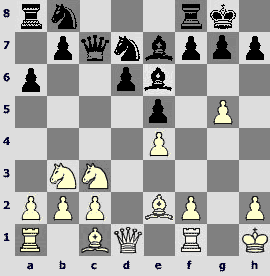
12.¤d5!?N (12.¦g1 – 70/252; 12.f4 – 70/253) 12...Ґxd5 13.exd5 ¤c5 14.¤xc5 Јxc5. Maybe more joyful is 14...dxc5 15.a4 c4 16.f4 ¤d7 17.f5 Ґd6 18.Ґe3 e4 19.Јd4 ¦ac8 20.g6 ¤f6 21.Ґg5 Ґe5 22.Јe3 fxg6 23.fxg6 h6 (23...hxg6!?) 24.Ґxf6 ¦xf6 25.¦xf6 Ґxf6 26.Јxe4 Јe5 27.Јxe5 Ґxe5 28.c3± Nisipianu – Leitao, Las Vegas, 1999. 
28...h6 29.h4. Too positional. Better is 29.Јa7! The threat of b5-b6, and 29...Ґxg5 is met by 30.Ґxg5 hxg5 31.c6ќ.
29...hxg5 30.hxg5 Јe7 31.Јa7 Ґc7 32.c6 b5. Black managed to block the position somehow.
34.Ґh3 ¤h7 35.Ґd7! Јd8 36.¦a1 ўg7 37.f4! exf4 38.Јd4+ ўg8 39.Јxf4 ¦a8 40.¦e1! ¤f8 41.Ґd4 ¤xd7 42.cxd7 Јxd7 43.Јh4 
1–0
One of the most favorite methods of the grandmaster is sending his queen to the enemy camp, attacking pawns and creating different threats somewhere.
Plovdiv 2003

21.f6! Ґxf6 22.e5 Ґg5 (22...Ґg7 23.Јe4±) 23.Ґf2 Јf4 24.¦e4 Јf5 25.Јe2. 1–0.
Haifa 1996
1.e4 e6 2.d4 d5 3.¤d2 c5 4.¤gf3 ¤c6 5.Ґb5 a6 6.Ґxc6+ bxc6 7.0–0 ¤f6 8.e5 ¤d7 9.c4 Ґe7 10.dxc5 (10.¤b3!? – Smirin – Zifroni, Israel 2003) 10...¤xc5 11.¤d4 Јb6 12.Јg4 0–0 13.¤2f3 f5 14.Јh5 (14.exf6 Ґxf6µ and e6-e5) 14...¤e4 15.cxd5 exd5 
16.¤e2 c5 17.b3 a5 18.Ґg5 ¤xg5 19.¤xg5 h6 20.¤h3 (20.¤f3 Јb4і (20...ўh7 21.¤f4 g6 22.Јh3) ) 20...g5 21.¦ad1 d4

Moscow 2001
16...Ґc8 17.¦fc1 ¤dc7 18.Ґf1 ¦d5 19.h4 g6 20.a3 c5 21.¤f3 b6 22.b4 ¤e6 23.¤c3 ¦f5 24.¤d2 
24...cxb4 25.axb4 ¤xb4 26.¦xa7 ¤c6 27.¦aa1 ¦d8 28.¤ce4 ¦a5 29.¦ab1 ¤e7 30.¦xb6 ўg7 31.Ґc4 ¤c5 32.¤b3± ¤xe4 33.¤xa5 ¦d2 34.Ґf1 ¤xf2 35.¤c4 ¦a2 36.¦b2 ¦xb2 37.¤xb2 ¤e4 38.¦c7 ўf6 39.ўh2 Ґe6 40.Ґg2 ¤f2 41.ўg1 ¤g4 42.e4 ¤e5 43.¤d1 ¤7c6 44.¤e3 ¤d4 45.Ґf1 ¤ef3+ 46.ўf2 g5 47.¤d5+ ўe5 48.Ґg2 g4 49.ўe3 ¤e1 50.Ґh1 f5 51.¤f4 ¤ec2+ 52.ўd2 fxe4 53.¦c5+ ўd6 54.¦xc2 e3+ 55.ўc3 ¤xc2 56.ўxc2 Ґf5+ 57.ўc3 ўe5 58.¤d3+ 1–0
Pune 2004
15...d3!? The first pawn sacrifice was done in order to open an attacking diagonal for the bishop.
18...f5?! The second sacrifice was done in order to ensnare white bishop on e6, where he does not take part in defense of the king, and to open a file for the rook.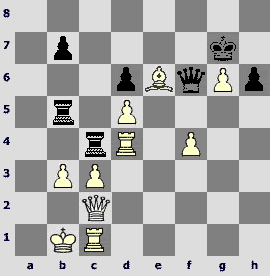
Buenos Aires 1997

10...Јa5 11.h4 c4 12.Ґe2 Јxa3 13.h5 h6 14.¦h3 b5 15.¦f3 Јb2 16.¤h3 a5 17.¤f4 ўg8

Another queen will appear on board very soon. Something needs to be done!
18...cxd3 19.Ґxd3 ¤f5 20.Јf4 ¦a7 (20...¤d8) 21.g4 ¤fxd4 (21...¤h4 22.¦g3 ¤e7 23.ўe2 g5 24.Јf6›) 22.¦g3 (22.cxd4 Јxd4 - fighting in the ending without pawns is not an easy task). 
22...¦e7. A move with an idea of returning the knight on f5 and capturing on e5 with a knight after the exchange on f5. Is there any possibility of getting more benefit from using the tempo that Black has? Let us try ignoring everything, except advance of the a-pawn: 22...a4 23.g5 a3 (23...¤f5) 24.gxh6 ¤f5 (24...a2 25.Јf6ќ) 25.Ґxf5 exf5 26.Јg5 f6 27.Јxf6ќ ok, it did not work; 22...b4 23.cxd4 Јxd4 24.Јxd4 ¤xd4 25.Ґe3 ¤c6 26.Ґxa7 ¤xa7 27.¦a1ѓ.
23.g5. Straight and regardless of obstacles. Maybe it was time to remember about the material? 23.cxd4 ¤xd4 ( It's already impossible to exchange queens: 23...Јxd4 24.Јxd4 ¤xd4 25.Ґc3 ¤c6 26.Ґxb5=) 24.ўd1 b4 ( there was a threat of Ґc3) 25.g5 ўf8 (25...¤f5 26.Ґxf5 exf5 27.gxh6 Јxe5 28.¦xg7+ ўf8 29.Јxe5 ¦xe5 30.¦a1 – White stands better with approximately equal material!) 26.gxh6 (26.Јg4 ¤f5 27.gxh6 gxh6 28.Ґxf5 exf5 29.Ґxh6+ ўe8!µ) 26...¦xh6 27.Јg4 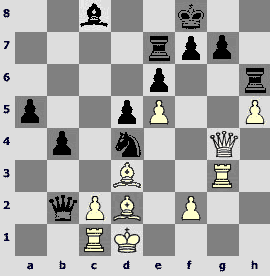
27...f5 28.exf6 ¦xf6 29.h6 ўg8 30.Ґg5 ¤f5 31.Ґxf6 Јxf6 32.Ґxf5 exf5 33.Јg5 Јd4+ 34.¦d3 Јe4 35.¦e3 Јd4+=.This is certainly a sample variation, but anyway I think this is the way White should have played.
26.¦xg7+ ўf8 27.Јg5 
Atlas, who annotated this game for ChessBase, considers 27...f6 to be the strongest. Though there are mistakes in his variations: 28.¦f7+ ўxf7 (28...ўe8!? 29.Јg7 ¤xe5 "deserves attention" – Atlas, 30.¦xf6 ¤f7+ 31.ўf1 ¦f8 32.h7 ¦xf6 33.Јxf6ќ) 29.Јg7+ ўe8 30.Јxh8+ ўd7 31.Јg7+ ¦e7 32.Јxe7+ ўxe7 33.h7 ¤xe5 34.h8Ј±, and how Black will stop the pawn h5 remains enigmatic. 
Atlas gives only 29.Јg7 ¦hxh6 30.Ґxh6 Јxc3+ 31.ўf1 Јh3+ 32.ўg1 Јxh5 33.¦xe7+ ¦xe7 34.Јg8+ ўd7 35.Јxd5+ ўe8 – "It's seems that White can not win" : 36.Јc6+ (36.¦d1? Јg6+ 37.Јg2 Јxg2+ 38.ўxg2 ¦xe5) 36...ўf7 37.Јf6+ ўe8=.
One fails to bring the queen back into play: 27...Јa3 28.h7 ¤e7, and by this moment the second h-pawn joins: 29.h6! ¦xe5+ (29...Јd6 30.¦g8+ ¤xg8 (30...¦xg8 31.hxg8Ј+ ¤xg8 32.Јg7+ ўe7 33.h7ќ) 31.Јg7+ ўe8 32.Јxh8ќ) 30.ўf1 Јd6 31.¦g8+ 
31...¤xg8 (31...¦xg8 32.hxg8Ј+ ¤xg8 33.Јg7+ ўe7 34.h7!ќ) 32.Јg7+ ўe7 33.Јxh8 ¤f6 34.Ґg5ќ.
28.Јd8+ ¦e8 29.Јd6+ ¦e7 30.ўd1! (…Ґg5)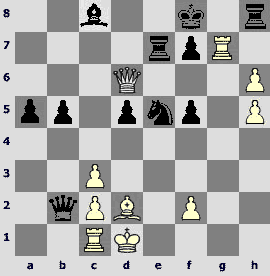
30...¤g4. This loses. But after 30...f4™ 31.Ґxf4 Јxc3= White would have to restrict himself to the perpetual. 
1–0
It makes sense to talk more about the latter of the listed factors – opening preparation.
Emil Sutovsky, like many other contemporary grandmasters, clearly divides all openings into "his own" and "the rest". "His own" being the Grünfeld (in which he as one of the world's leading experts together with Garry Kasparov and Peter Svidler), the Najdorf, the Sveshnikov as Black, various anti-Sicilian and anti-Spanish schemes with exchange on c6.
This is not by a chance – Emil clearly tries to avoid locked positions, pawn chains, long maneuvers and, in general, complex strategic play. On the contrary, he strives for creating a conflict of tactical nature on the board as early as possible – and then it is preferable to get rid of some central pawns.
One can find another pattern in Sutovsky's decisions in early middlegame stage. If there is a choice between unclear forced line with definite counterplay and mere keeping the tension without clear targets, he will definitely choose the former.
T.Hillarp Persson – E.Sutovsky
York 1999
A well-known line of the Grünfeld Defense. One cannot say that White got a lot out of the opening – he is a pawn down, and the c-file domination will suffice for equality at most. It is clear that Sutovsky was as well aware of normal and quiet 21...Јd6 as the commentator. Nevertheless, the Israeli grandmaster as usual selected a sharper continuation.
21...¦ac8!? (21...Јd6) 22.¦xc8 ¦xc8 23.¦xc8+ Јxc8 24.Јxe7 h6. An important move, which frees black queen of the back rank defense duties.
25.Ґf4. 25.Ґe3!? is safe and solid – the pawn is protected, and both c1 and d2 squares are guarded. 25...Јc2 26.ўf2 ¤c4 (26...Јd3 27.Јe8+ќ …ўh7 28.Јxf7 ¤c4 29.Јxg6+ќ) 27.Јe8+ ўh7 28.Јxf7 ¤b2 29.Ґf4 ¤d3+ 30.ўe3 ¤b2=.
25...Јc2 26.ўf1 g5 27.Јe8+ ўh7 28.Ґg3? And now one begins to smell a rat. White had to offer the bishop trade – 28.Ґe5 f6 29.Ґg3 ¤c4 30.d5 – Black has nothing more than perpetual check, and if he tries to bring the bishop into action by 30...f5, then just 31.exf5 Јxf5 32.d6. 28.Ґe3 ¤c4µ.
28...Јc4 29.d5 (29.Ґe5 f6 30.Ґg3 ¤b3) 29...¤b3 
30.Јc6?
30.ўe1! I honestly can't agree with Michal Krasenkow who called this move "computer-like". It is not too difficult to go off the pin with the king. It seems White was just taken aback. 30...¤c1 31.¤xc1 Јxc1+ 32.ўe2 Јc4+ 33.ўd1 Јd3+ 34.ўc1 Јf1+ 35.ўd2 Јxg2+ 36.ўe3 – the pawn on d5 is too strong, so Black has to agree to a perpetual check.
30...Јd3 31.Ґf2 (31.ўf2 ¤d4 32.¤xd4 Ґxd4+ 33.ўe1 Ґc3+ 34.ўf2 Јd2+ 35.ўf1 Јd1+ 36.ўf2 Јe1#) 31...Јd1+ 32.Ґe1 ¤c5 (32...¤c5 33.Јc8 ¤d3 34.Јf5+ ўg8 35.Јc8+ Ґf8 36.Јc3 Ґb4 37.Јc8+ ўg7°) 0–1
I don't want to draw the picture of some kind of berserk who only wants to sacrifice something and deliver a blow, but has little chances to succeed in positional play. None of it can be said about Emil Sutovsky. The Israeli grandmaster possesses a fine technique, and here is one of the examples.
E.Sutovsky – M.Sorokin C83
Sochi 2005
1.e4 e5 2.¤f3 ¤c6 3.Ґb5 a6 4.Ґa4 ¤f6 5.0–0 ¤xe4 6.d4 b5 7.Ґb3 d5 8.dxe5 Ґe6 9.¤bd2 ¤c5 10.c3 Ґe7 11.Ґc2 d4 12.¤b3 d3 13.¤xc5 dxc2 14.Јxd8+ ¦xd8 15.¤xe6 fxe6 16.Ґe3 ¦d5 17.¦fc1 ¤xe5 18.¤xe5 ¦xe5 19.¦xc2 
A well-known in theory endgame with White's minimal advantage emerged.
19...ўf7 20.c4 b4 21.¦d1 ¦d8 22.¦xd8 Ґxd8 23.ўf1 Ґg5 24.Ґa7 Ґe7 25.¦e2 ¦f5 26.Ґe3 h5 27.g3 g5 28.h3 Ґd6 29.g4 hxg4 30.hxg4 ¦a5 31.b3 ўf6 32.Ґd2 ¦a3 33.ўg2 Ґe7 34.ўf3 ўf7 35.Ґe3 ¦a5 36.ўe4 ўg6 37.¦c2 ўf7 
38.Ґd2! Ґd6 39.a4. White managed to get rid of his main weakness, having utilized the fact that black rook had no retreat squares on the previous move.
39...¦e5+ 40.ўd3 a5 41.¦c1 Ґe7 42.¦h1 ¦c5 (42...ўg6 43.¦h8±; 42...ўg7 43.¦h5 … f4) 43.Ґe3 ¦c6 44.¦h7+ ўf6 (44...ўe8 45.¦h5ќ) 45.Ґd4+ 1–0.
Let us sum it up in a few words.
Natural basis of our hero's chess strength is of course his excellent tactical sight and, moreover, significant calculating skills. He does his calculations impressively quick and with outstanding quality.
One could make a good book of tactical puzzles for advanced players based solely on Sutovsky's games. It could include, for example, the following blows.
E.Sutovsky – S.Movsesian
Ohrid 2001
One of the cutest small combinations of Sutovsky.
48.¦e7! ¤xd5 49.¦e8! ¤f4 (49...Јg5+ 50.Јg2! Јxg2+ 51.ўxg2 ¤f4+ 52.ўg3 ¤e6 53.¦xe6 ¦xf7 54.¦xa6ќ) 50.¦xf8+! Јxf8 51.Јe8 ¤g6 
52.b4! ўh7 53.Јxf8 ¤xf8 54.bxc5 ¤e6 55.c6. One of the pawns promotes inevitably, so Black resigned.
E.Sutovsky – O.Cvitan
Bled 2002
21...e5? 22.fxe5 ¤xe5 23.¦xf7+! ¤xf7 24.¤e6 Јd7 25.Јf6. 25.¤xf8+! is even better: 25...¦xf8 26.Јf6 ¤f5 27.exf5 ¦g8 28.¤e4 gxf5 (28...Ґxe4 29.Ґxe4 gxf5+ 30.¦g3ќ) 29.Јg7+! ¦xg7 30.¤f6+ ўg6 31.¤xd7ќ – Sutovsky.
25...Јxe6 26.Јxe6 ¤e5
27.Јxd6? (it is better to keep the queen – 27.Јb3! ¦ab8 28.Ґf4ќ) 27...¤d5! 28.Јxd5?! (28.Јxf8 ¦xf8 29.¤xd5±) 28...Ґxd5 29.¤xd5 Ґc5+ 30.ўh1 ¦f8 31.b4 Ґd6 32.¤xb6?! (32.ўg1) 32...¦ad8! 33.¤d5 ¦f5, and excessively creative play of our hero gave Black real chances.
A.Zapata – E.Sutovsky
Moscow 2001
25.¦xf6? (25.¦6d2=) 25...Јc2 26.¦e6 Јc5+ 27.ўh1 Јxh5° 0–1
One should also add that Sutovsky possesses great imagination and is not prone to stereotyped thinking. He sacrifices material, exchanges bishops for knight, etc. with light heart.
Take a look at the following example.
E.Sutovsky – L.Psakhis
Ramat Aviv 2000
13.Ґf4!? ¤7g6 14.Ґxg6!? hxg6 15.Ґxe5!? Ґxe5 16.Јf3 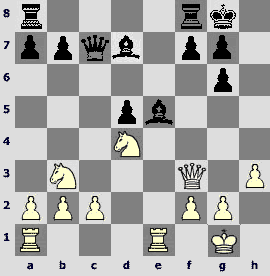
A non-standard trade of both bishops, which was by no means forced.
16...Јd6 17.¦ad1 ¦fe8 18.c3 Ґc6 19.Јd3 Ґf6 20.¤b5 ¦xe1+ 21.¦xe1 Јf4 22.¤5d4 ¦e8 23.¦xe8+ Ґxe8 24.Јe2 ўf8 25.g3 Јd6 26.h4 Ґd8 27.¤f3 Ґb6 28.¤bd4 Јe7 29.Јd3 f6 30.ўf1 ўf7 31.h5 gxh5 32.Јh7 Јe4 33.Јxh5+ ўg8 34.Јh3 Ґb5+ 35.¤xb5 Јxf3 36.¤d4 Ґxd4 37.Јc8+ ўh7 38.cxd4 Јh1+ 39.ўe2 Јe4+ 40.ўf1 b6 41.Јc3 Јb1+ 42.ўg2 Јxa2 43.Јc2+ ўg8 44.Јc8+ ўh7 Ѕ–Ѕ
Sutovsky's opening repertoire was created and sharpened for the player's style. In most cases Emil succeeds in obtaining positions of the kind he needs, although sometimes it is connected with excessive degree of risk.
In contrast to a majority of players of his level, Sutovsky does not like (albeit he is capable of) playing solidly – making reasonable moves without any concessions in accordance to the positional demands and waiting for the opponent's mistake or unsound activity. Sutovsky is an expressive man; he likes to play himself and allows the others to play, too.
Such style has its own advantages and disadvantages. For example, if you are playing a system in which Black holds only on a long tactical variation (shown in one of your previous games), it is clear that the slightest error in that variation may lead to a difficult position. However, such production costs are repaid with interest, because it is the kind of chess you and others like, which brings not only material satisfaction with points in a tournament table, but also great creative delight.
ALL ARTICLES BY AUTHOR
